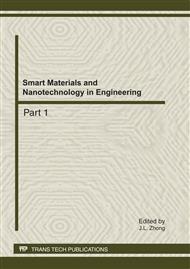[1]
Wang Xingjun; Cao Baosheng; Lei Mingkai, Photoluminescence Properties of Er3+-Yb3+ Co-doped Al2O3 Powders Prepared by Sol-gel Method, ACTA PHOTONICA SINICA, 2004, Vol. 33, No. 8, pp.935-938.
DOI: 10.1016/j.optmat.2004.01.011
Google Scholar
[2]
Lei Hongbing; Yang Qinqing; Ou Haiyan; et al., Mechanism on Energy Transfer of Photoluminescence Exciton in Erbium Doped Silicon, CHINESE JOURNAL OF SEM ICONDUCTORS, 1999, Vol. 21, No. 3. pp.232-238.
Google Scholar
[3]
Li C R, Song C L, Li S F, et al. Deposition of Er: A12O3 fiims and photoluminescence. Chinese Physics, 2003, Vol. 20, No. 9, pp.1613-1615.
Google Scholar
[4]
Seo S T, Shin J H. Exciton-erbium coupling and the excitation dynamics of Er3+ in erbium-doped silicon-richsilicon oxide. Appl Phys Lett, 2001, Vol. 78, No. 18, pp.2709-2711.
DOI: 10.1063/1.1369150
Google Scholar
[5]
Chen Haiyan, Liu Yongzhi, Dai Jizhi1, et al. , Design of Er3+-Yb3+ Co-Doped Phosphate Glass (LGS-L) Waveguide Amplifier, ACTA OPTICA SINICA, 2003, Vol. 23, No. 6, pp.697-701.
Google Scholar
[6]
Gao Jingsheng, Song Changlie, Li Chengren, et al., Photoluminescence of Yb3+/Er3+ Co-doped Al2O3 Film Fabricated by Medium Frequency Sputter, Journal of Optoelectronics Laser, 2004, Vol. 15, No. 10, pp.1162-1165.
Google Scholar
[7]
Li Chengren, Song Changlie, Li Shufeng, et al., Comparison of Photoluminescent Characteristics between Er-doped Al2O3 Film and Yb-Er Co-doped Al2O3 Film, SEMICONDUCTOR OPTOELECTRONICS, 2005, Vol. 26, No. 3, pp.57-62.
DOI: 10.1007/s12200-008-0081-6
Google Scholar
[8]
Yang Xianglin, Optical Amplifier and Its Application [M], Publishing House of Electronics Industry, 2000, pp.28-74.
Google Scholar
[9]
Chen Haiyan, Study on Key Technologies of Broad-Band Er-Doped Optical Waveguide Amplifiers[D]. University of Electronic Science and Technology of China, 2004, pp.18-47.
Google Scholar
[10]
Zhang Qingli, He Wei, Sun Dunlu, et al., Judd-Ofelt Spectral Theory [J]. Spectroscopy and Spectral Analysis, 2005, Vol. 25, No. 3, pp.329-333.
Google Scholar
[11]
Li Shufeng, Li Chengren, Song Changlie, Er-Doped and Yb-Er Co-Doped A12O3 Waveguide Amplifier, ACTA OPT ICA SINICA, 2007, Vol. 27, No. 5, pp.928-933.
Google Scholar
[12]
LI Chengren, Song Changlie, Li Shufeng, et al., Simulation for the Net Gains of Rib Er-doped Waveguide Amplifiers and Effect of Side-sculpture on the Net Gains. SEMICONDUCTOR OPTOELECTRONICS, 2005, Vol. 26, No. 1, pp.14-19.
Google Scholar


